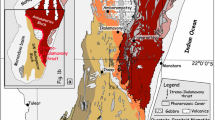Abstract
The E-W running Salem-Attur shear zone demarcates the tectonic boundary between Archaean Dharwar Craton in the north and Proterozoic Southern granulite terrane in the south. This study reveals that the shear zone is a low angle thrust. The thrust zone is around 10 m thick and it merges with the main shear zone along the strike. The thrust is developed on charnockite near Odyarpatti, which is retrograded into schists. Further, it is marked by gently dipping mylonitic foliation and subhorizontal lineation. The S-C fabric, mantled porphyroclasts and intragranular faults indicate northeasterly slip along the thrust. Recumbent shear folds SF1 are developed within the thrust zone. The thrust has been folded by late stage F2 fold which has brought variation in the orientation of the mylonitic foliation from subhorizontal to vertical attitude; the mylonitic lineations have been rotated to subvertical orientation also. Additionally, the F2 crenulations and shear cleavages and intersection lineations are superimposed on the mylonitic fabric. Thrusting along the Salem-Attur shear zone is probably the cause for upliftment of the charnockites to the upper crust. Post-upliftment stage has witnessed brittle deformation in the form of development of shear fractures in NNE-SSW and E-W directions. Pseudotachylites are emplaced along these fractures.
Similar content being viewed by others
References
Bhaskar Rao, Y.J., Naha, K., Srinivasan, R. and Gopalan, K. (1991) Geology, geochemistry and geochronology of Peninsular gneisses around Gorur, Hassan district, Karnataka. Proc. Indian Acad. Sci. Earth Planet. Sci., v.100, pp.399–412.
Bhaskar Rao Y.J., Janardhan, A.S., Vijaya Kumar, T., Narayana, B.L., Dayal, A.M., Taylor, P.N. and Chetty, T.R.K. (2003) Sm-Nd model ages and Rb-Sr isotopic systematic of charnockites and gneisses across Cauvery shear zone, southern India: Implication for the Archean-Neoproterozoic Terrane Boundary in the Southern Granulite Terrane. Mem. Geol. Soc. India, v.50, pp.297–317.
Bhadra, B.K. (2000) Ductile shearing in Attur shear zone and its relation with Moyar shear zone, South India. Gondwana Res., v.3, pp.361–369.
Biswal, T.K., Waele, B.D. and Ahuja, H. (2007) Timing and dynamics of the juxtaposition of the Eastern Ghats Mobile Belt against the Bhandara Craton, India: A structural and zircon U-Pb SHRIMP study of the fold-thrust belt and associated nepheline syenite plutons. Tectonics, v.26, TC4006
Chetty, T.R.K. and Bhaskar Rao, Y.J. (1998) Behavior of stretching lineation in the Salem-Attur shear belt, Southern Granulite terrane, south India. Jour. Geol. Soc. India, v.52, pp.443–448.
Chetty, T.R.K. and Bhaskar Rao, Y.J. (2006) Constrictive deformation in transpressional regime: field evidence from the Cauvery Shear Zone, Southern Granulite Terrane, India. Jour. Struct. Geol., v.28, pp.713–720.
Devaraju, J. and Janardhan, A.S. (2004) Metamorphic history of staurolite-kyanite-garnet-cordierite bearing pelites of Mangalore-Mercara lineament, South India. Jour. Geol. Soc. India, v.63, pp.555–561.
Drury, S.A. and Holt, R.W. (1980) The tectonic framework of the south Indian Craton, a reconnaissance involving Land sat imagery. Tectonophysics, v.65, pp.T-1–T15.
Ghosh, J.G., DE Wit, M.J. and Zartman, R.E. (2004) Age and tectonic evolution of Neoproterozoic ductile shear zones in the Southern Granulite Terrane of India, with implications for Gondwana studies, Tectonics, v.23, TC3006.
Harris, N.B.W., Santosh, M. and Talor, P. N. (1994) Crustal evolution in south India: Constraints from Nd isotopes. Jour. Geol., v.102, pp.139–150.
Jain, A.K., Singh, S. and Manickavasagam, (2003) Intracontinental Shear Zones in the Southern Granulite terrane: Their kinematics and Evolution. Mem. Geol. Soc. India, v.50, pp.225–253.
Janardhan, A.S., Francis Anto, K. and Sivasubramanian, P. (1996) Evolution of the Proterozoic southern granulite terrane: Its position in eastern Gondwana. Gondwana Research Group Misc. Publ., v.4, pp.38–39.
Lin, S. Jiang, Dazhi and William, P.F. (2007) Importance of differentiating ductile slickenside striation from stretching lineation and variation of shear direction across a high strain zone. Jour. Struct. Geol., v.29, pp.850–862.
Naha, K. and Srinivasan, R. (1996) Nature of Moyar and Bhavani shear zone with a note on its implication on the tectonics of the southern Indian Peninsula shield. Proc. Aca. Sci. (Earth Planet.Sci), v.105, pp.173–189.
Passchier, C.W. and Coelho, S. (2006) An outline of shear-sense analysis in high-grade rocks. Gondwana Res., v.10, pp.66–76.
Raith, M., Srikantappa, C., Ashamanjari, K.G. and Spiering, B. (1990) The granulite terrane of the Nilgiri Hills (South India). In: D. Viezeuf and P. Vidal (Eds.), Granulites and crustal evolution. Kluwer Publ., pp.339–365.
Ramakrishnan, M. (2003) Craton-Mobile Belt relations in Southern Granulite Terrane. Mem. Geol. Soc. India, v.50, pp.1–24.
Santosh, M., Maruyama Shigenoriand Kei Sato (2009) anatomy of a cambrian suture in gondwana: pacific-type orogeny in southern india? gondwana res., 2009, in press.
Satheesh Kumar, R. and Prasannakumar, V. (2008) Fabric evolution in Salem-Attur Shear Zone, South India, and its implications on the kinematics, Gondwana Res., doi: 10.1016/ j. gr. 2008. 10.006.
Srikantappa, C., Ashamanjari, K.G. and Raith, M. (1988) Petrology and geochemistry of the high pressure Nilgiri granulite terrane, South India. Jour. Geol. Soc. India, v.31, pp.147–148.
Valdiya, K.S. (1998) Late quaternary movement and landscape rejuvenation in SE Karnataka and adjoining TN in south Indian shield. Jour. Geol. Soc. India, v.51, pp.139–166.
Vijaya Rao, V. and Rajendra Prasad, B. (2006) Structure and evolution of the Cauvery Shear Zone system, Southern GranuliteTerrane, India: Evidence from deep seismic and other geophysical studies. In: T.R.K. Chetty, I.C.W. Fitzsimons, L.D. Brown, V.P. Dimri and M. Santosh (Eds.), Crustal Structure and Tectonic Evolution of the Southern Granulite Terrane, India. Mem. Gondwana Res., pp.29–40.
Author information
Authors and Affiliations
Corresponding author
Rights and permissions
About this article
Cite this article
Biswal, T.K., Thirukumaran, V., Ratre, K. et al. A study of mylonites from parts of the Salem-Attur shear zone (Tamil Nadu) and its tectonic implications. J Geol Soc India 75, 128–136 (2010). https://doi.org/10.1007/s12594-010-0002-3
Received:
Accepted:
Published:
Issue Date:
DOI: https://doi.org/10.1007/s12594-010-0002-3




